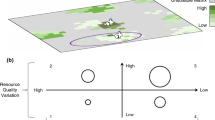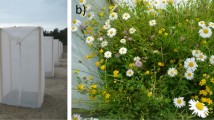Abstract
Herbivorous insects flux considerable amounts of nitrogen from the forest canopy to the soil in the form of frass. The amount of nitrogen fluxed varies depending on the characteristics of the herbivores, their food resources, and their physical environment. We used concepts from metabolic ecology and ecological stoichiometry to develop a general model of individual nitrogen flux via frass fall for moth and sawfly larvae from a temperate hardwood forest in northern Wisconsin, USA. We found that individual nitrogen flux (Q N, mg N/day) was related to larval body mass (M B, mg dry), short-term variation in environmental temperature (T, K), and larval nitrogen concentration (N B, proportion dry mass) as Q N = e25.75 M 0.77B e−0.83/kT N −1.56B , where k is Boltzmann’s constant (8.62 × 10−5 eV/K). We also found that larval nitrogen flux did not vary with the nitrogen concentration of food, and suggest that this was due to compensatory feeding by larvae living on low-quality leaves. With further work, models of individual N flux could be used to scale individual fluxes to population and community levels, and thus link the characteristics of insect herbivore communities with the flow of nitrogen through forested ecosystems.


Similar content being viewed by others
References
Allen AP, Gillooly JF, Brown JH (2005) Linking the global carbon cycle to individual metabolism. Funct Ecol 19:202–213
Banavar JR, Damuth J, Maritan A, Rinaldo A (2002) Supply–demand balance and metabolic scaling. Proc Natl Acad Sci USA 99:10506–10509
Belovsky GE, Slade JB (2000) Insect herbivory accelerates nutrient cycling and increases plant production. Proc Natl Acad Sci USA 97:14414–14417
Blueweiss L, Fox H, Kudzma V, Nakashima D, Peters RH, Sams S (1978) Relationships between body size and some life history parameters. Oecologia 37:257–272
Bowers MD, Stamp NE, Fajer ED (1991) Factors affecting calculation of nutritional induces for foliage-fed insects: an experimental approach. Entomol Exp Appl 61:101–116
Brett JR, Groves TDD (1979) Physiological energetics. In: Hoar WS, Randall DJ, Brett JR (eds) Fish physiology, vol 8. Academic, New York, pp 272–352
Brody S (1945) Bioenergetics and growth, with special reference to the efficiency complex in domestic animals. Reinhold, New York
Brown JH, Gillooly JF, Allen AP, Savage VM, West GB (2004) Toward a metabolic theory of ecology. Ecology 85:1771–1789
Cammen LM, Seneca ED, Stroud LM (1980) Energy flow through the fiddler crabs Uca pugnax and U. minax and the marsh periwinkle Littorina irrorata in a North Carolina salt marsh. Am Midl Nat 103:238–250
Carpenter SR, Kitchell JF (1988) Consumer control of lake productivity. Bioscience 38:764–769
Clark JE, Hellgren EC, Parsons JL, Jorgensen EE, Engle DM, Leslie DM Jr (2005) Nitrogen outputs from fecal and urine deposition of small mammals: implications for nitrogen cycling. Oecologia 144:447–455
Clarke A, Johnston NM (1999) Scaling of metabolic rate with body mass and temperature in teleost fish. J Anim Ecol 68:893–905
Crozier WJ (1924) On biological oxidations as function of temperature. J Gen Physiol 7:189–216
Cruz-Rivera E, Hay ME (2000) Can quantity replace quality? Food choice, compensatory feeding, and fitness of marine mesograzers. Ecology 81:201–219
Cunningham SA, Murray W (2007) Average body length of arboreal and aerial beetle (Coleoptera) assemblages from remnant and plantation Eucalyptus forests in southwestern Australia. Oecologia 151:303–312
Ejsmont-Karabin JL (1984) Phosphorus and nitrogen excretion by lake zooplankton (rotifers and zooplankton) in relationship to individual body weights of the animals, ambient temperature and presence or absence of food. Ekologia Polska 32:3–42
Elser JJ, Urabe J (1999) The stoichiometry of consumer-driven nutrient recycling: theory, observations, and consequences. Ecology 80:735–751
Elser JJ, Dobberfuhl DR, MacKay NA, Schampel JH (1996) Organism size, life history, and N:P stoichiometry. Bioscience 46:674–684
Enquist BJ, Economo EP, Huxman TE, Allen AP, Ignace DD, Gillooly JF (2003) Scaling metabolism from organisms to ecosystems. Nature 423:639–642
Eshleman KN, Morgan RP, Webb JR, Deviney FA, Galloway JN (1998) Temporal patterns of nitrogen leakage from mid-Appalachian forested watersheds: role of insect defoliation. Water Resour Res 34:2005–2016
Evans-White MA, Lamberti GA (2006) Stoichiometry of consumer-driven nutrient recycling across nutrient regimes in streams. Ecol Lett 9:1186–1197
Fagan WF, et al (2002) Nitrogen in insects: implications for trophic complexity and species diversification. Am Nat 160:784–802
Fink P, Von Elert E (2006) Physiological responses to stoichiometric constraints: nutrient limitation and compensatory feeding in a freshwater snail. Oikos 115:484–494
Fogal WH, Slansky F (1985) Contribution of feeding by European pine sawfly larvae to litter production and element flux in scots pine plantations. Can J For Res 15:484–487
Fox LR, Macauley BJ (1977) Insect grazing on Eucalyptus in response to variation in leaf tannins and nitrogen. Oecologia 29:145–162
Frost CJ, Hunter MD (2007) Recycling of nitrogen in herbivore feces: plant recovery, herbivore assimilation, soil retention, and leaching losses. Oecologia 151:42–53
Gillooly JF, Brown JH, West GB, Savage VM, Charnov EL (2001) Effects of size and temperature on metabolic rate. Science 293:2248–2251
Gillooly JF, Allen AP, Brown JH, Elser JJ, Martinez del Rio C, Savage VM, West GB, Woodruff WH, Woods HA (2005) The metabolic basis of whole-organism RNA and phosphorus content. Proc Natl Acad Sci USA 102:11923–11927
Gillooly JF, Allen AP, Savage VM, Charnov EL, West GB, Brown JH (2006) Response to Clarke and Fraser: effects of temperature on metabolic rate. Funct Ecol 20:400–404
Glazier DS (2005) Beyond the “3/4-power law”: variation in the intra and inter-specific scaling of metabolic rate in animals. Biol Rev 80:611–662
Green GW, deFreitas AS (1955) Frass-drop studies of larvae of Neodiprion americanus banksianae Roh. and N. lecontei (Fitch) (Hymenoptera: Diprionidae). Can Entomol 87:427–440
Grimm NB (1988) Role of macroinvertebrates in nitrogen dynamics of a desert stream. Ecology 69:1884–1893
Grodzinski W, Klekowski RZ, Duncan A (1975) Methods for ecological bioenergetics. Blackwell, Oxford
Hargrave B (1972) Prediction of egestion by the deposit feeding amphipod, Hyalella azteca. Oikos 23:116–124
Hemmingsen AM (1960) Energy metabolism as related to body size and respiratory surfaces, and its evolution. Rep Steno Meml Hosp Nordisk Insulin Lab 9:6–110
Hill RW, Wyse GA, Anderson M (2004) Animal physiology. Sinauer Associates, Sunderland, MA
Hollinger DY (1986) Herbivory and the cycling of nitrogen and phosphorous in isolated California oak trees. Oecologia 70:291–297
Hunter MD, Linnen CR, Reynolds BC (2003) Effects of endemic densities of canopy herbivores on nutrient dynamics along a gradient in elevation in the southern Appalachians. Pedobiologia 47:231–244
IPCC (2001) Climate change 2001: synthesis report. A contribution of Working Groups I, II, and III to the Third Assessment Report of the Intergovernmental Panel on Climate Change. Cambridge University Press, Cambridge
Kagata H, Ohgushi T (2006) Nitrogen homeostasis in a willow leaf beetle, Plagiodera versicolora, is independent of host plant quality. Entomol Exp Appl 118:105–110
Kingsolver JG, Woods HA (1998) Interactions of temperature and dietary protein concentration in growth and feeding of Manduca sexta caterpillars. Physiol Entomol 23:354–359
Kleiber M (1932) Body size and metabolism. Hilgardia 6:315–353
Lavigne DM (1982) Similarity in energy budgets of animal populations. J Anim Ecol 51:195–206
Lavoie B, Oberhauser KS (2004) Compensatory feeding in Danaus plexippus (Lepidoptera: Nymphalidae) in response to variation in host plant quality. Environ Entomol 33:1062–1069
Lovett GM, Ruesink AE (1995) Carbon and nitrogen mineralization from decomposing gypsy-moth frass. Oecologia 104:133–138
Lovett GM, Christenson LM, Groffman PM, Jones CG, Hart JE, Mitchell MJ (2002) Insect defoliation and nitrogen cycling in forests. Bioscience 52:335–341
Lovett GM, Canham CD, Arthur MA, Weathers KC, Fitzhugh RD (2006) Forest ecosystem response to exotic pests and pathogens in eastern North America. Bioscience 56:395–405
Mattson WJ, Addy ND (1975) Phytophagous insects as regulators of forest primary production. Science 190:515–522
McDiffett WF (1970) The transformation of energy by a stream detritivore, Pteronarcys scotti (Plecoptera). Ecology 51:975–988
McNaughton SJ, Ruess RW, Seagle SW (1988) Large mammals and process dynamics in African ecosystems. Bioscience 38:794–800
Meehan TD (2006) Mass and temperature dependence of metabolic rate in litter and soil invertebrates. Physiol Biochem Zool 79:878–884
Nation JL (2002) Insect physiology and biochemistry. CRC, Boca Raton, FL
Peters RH (1983) The ecological implications of body size. Cambridge University Press, Cambridge
Peters RH, Rigler FH (1973) Phosphorous release by Daphnia. Limnol Oceanogr 18:821–839
Peters RH, Cabana G, Choulik O, Cohen T, Griesbach S, McCanny SJ (1996) General models for trophic fluxes in animals based on their body size. Ecoscience 3:365–377
Raubenheimer D (1992) Tannic acid, protein, and digestible carbohydrate: dietary imbalance and nutritional compensation in locusts. Ecology 73:1012–1027
Raubenheimer D, Simpson SJ (2004) Organismal stoichiometry: quantifying non-independence among food components. Ecology 85:1203–1216
Reynolds BC, Hunter MD (2001) Responses of soil respiration, soil nutrients, and litter decomposition to inputs from canopy herbivores. Soil Biol Biochem 33:1641–1652
Robinson WR, Peters RH, Zimmerman J (1983) The effects of body size and temperature on metabolic rate of organisms. Can J Zool 61:281–288
Schaus MH, Vanni MJ, Wissing TE, Bremigan MT, Garvey JE, Stein RA (1997) Nitrogen and phosphorus excretion by detritivorous gizzard shad in a reservoir ecosystem. Limnol Oceanogr 42:1386–1397
Simandl J (1993) Influence of temperature on larval defecation and its use in estimating canopy population size of pine sawflies (Hymenoptera: Diprionidae). Bull Entomol Res 83:245–249
Slansky F, Feeny P (1977) Stabilization of the rate of nitrogen accumulation by larvae of the cabbage butterfly on wild and cultivated food plants. Ecol Monogr 47:209–228
Smith PH (1972) Energy relations of defoliating insects in a hazel coppice. J Anim Ecol 41:567–587
Sterner RW, Elser JJ (2002) Ecological stoichiometry: the biology of elements from molecules to the biosphere. Princeton University Press, Princeton, NJ
Sterner RW, Elser JJ, Hessen DO (1992) Stoichiometric relationships among producers, consumers and nutrient cycling in pelagic ecosystems. Biogeochemistry 17:49–67
Swank WT, Waide JB, Crossley DA, Todd RL (1981) Insect defoliation enhances nitrate export from forest ecosystems. Oecologia 51:297–299
Throop HL, Lerdau MT (2004) Effects of nitrogen deposition on insect herbivory: implications for community and ecosystem processes. Ecosystems 7:109–133
Vanni MJ (2002) Nutrient cycling by animals in freshwater ecosystems. Annu Rev Ecol Syst 33:341–370
Vanni MJ, Flecker AS, Hood JM, Headworth JL (2002) Stoichiometry of nutrient recycling by vertebrates in a tropical stream: linking species identity and ecosystem processes. Ecol Lett 5:285–293
Vasseur DA, McCann KS (2005) A mechanistic approach for modeling temperature-dependent consumer–resource dynamics. Am Nat 166:184–198
Webb JR, Cosby BJ, Deviney FA, Eshleman KN, Galloway JN (1995) Change in the acid–base status of an Appalachian mountain catchment following forest defoliation by the gypsy moth. Water Air Soil Pollut 85:535–540
Wen YH, Peters RH (1994) Empirical models of phosphorous and nitrogen excretion rates by zooplankton. Limnol Oceanogr 39:1669–1679
West GB, Brown JH (2005) The origin of allometric scaling laws in biology from genomes to ecosystems: towards a quantitative unifying theory of biological structure and organization. J Exp Biol 208:1575–1592
West GB, Brown JH, Enquist BJ (1997) A general model for the origin of allometric scaling in biology. Science 276:122–126
Withers PC (1992) Comparative animal physiology. Saunders, New York
Acknowledgments
Thanks to Mike Hillstrom and Phil Pellitteri for assistance with larval identification; Julie Doll, John Albright, and John Craig for assistance with nitrogen analyses; and Adam Gusse and Andy Vogelzang for help with tussock moth rearing. Thanks to Chris Frost and three anonymous reviewers for their thoughtful comments on previous versions of this manuscript. This project was partially funded by the Office of Science (Biological and Environmental Research) of the US Department of Energy under award numbers DE-FG02-05ER64112 and DE-FG02-06ER64232.
Author information
Authors and Affiliations
Corresponding author
Additional information
Communicated by Richard Karban.
Rights and permissions
About this article
Cite this article
Meehan, T.D., Lindroth, R.L. Modeling nitrogen flux by larval insect herbivores from a temperate hardwood forest. Oecologia 153, 833–843 (2007). https://doi.org/10.1007/s00442-007-0797-9
Received:
Accepted:
Published:
Issue Date:
DOI: https://doi.org/10.1007/s00442-007-0797-9




